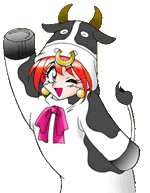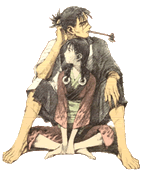What
is Anime?
Anime (ah-NIH-may)
is a term for Japanese animation. Anime often covers more serious
topics than the typical cartoon. In America, cartoons are considered
a form of entertainment meant for children. In Japan, people of
all ages watch anime. Most shows and movies are centered for kids,
adolescents, or young adults, but there are also many anime that
are made for the older crowd, even businessmen. There are many genres in anime with basic categories
like comedy, romance, action, drama, and pornography (hentai).
There are also anime with content meant specifically for boys (shounen),
girls (shoujo),
and businessmen. For more detailed explanations of the types of
anime, take a look at our Genres section
and hopefully you will learn something while viewing some great
pictures.
businessmen. There are many genres in anime with basic categories
like comedy, romance, action, drama, and pornography (hentai).
There are also anime with content meant specifically for boys (shounen),
girls (shoujo),
and businessmen. For more detailed explanations of the types of
anime, take a look at our Genres section
and hopefully you will learn something while viewing some great
pictures.
The
Art of Anime
Probably the
most readily apparent differences between Japanese animation and
other places is the artwork. Huge eyes, brightly colored hair, well-endowed
female characters, and exaggerated emotional expressions and gestures
are typical of anime style. Early anime artists were largely influenced
by early Disney characters like the Seven Dwarves from Snow White,
Mickey Mouse, and the non-Disney Betty Boop. All of these characters
had large eyes, and Betty Boop was certainly well-endowed. If you
want to know more about anime's artistic conventions, take a peek
at our General Information section.
Culture
in Anime
Understanding
the culture of origin is important in truly understanding what is
going on in a just about any art from a particular people be it
Japanese anime or manga, or American sitcoms (situation comedies).
If you have watched any amount of anime you, along with most people
living outside of Japan, probably noticed that the characters behave
differently and things in general (houses, transportation, eating,
sleeping, greeting, and much, much more) are a bit different from
what you are used to. Some of the differences are because of strange
artistic visions, but most of the differences are a direct result
of culture. Anime is an art form, and as art, it expresses many
things about Japan and its people. The behavior of characters, and
the influence of religion are just a couple of the cultural aspects
are covered in the History and Culture
section. If you want to get a peek at some of the fun things (besides
watching anime) take a look at Fun Stuff and
Games where you can play Anigotchi, based on
a wildly popular game in Japan.
Formats
of Anime
Anime is not
just movies; publishers release anime in many formats. There are
OVAs
(or OAVs), movies, and television shows. Don't let the direct-to-video
aspect of OVAs fool you, they aren't low-budget sequels trying to
capitalize on the success of a movie. Many of them are high-quality
stories that can't be properly condensed into a feature-length movie,
and the stories are generally more intricate than those found in
a daily or weekly half-hour television show. Anime have original
stories while others draw their stories and characters from Japanese
comic books (manga).
Watching
Anime Outside of Japan
 Anime
is widely available outside of Japan although only select stories
are available; usually only the most commercially successful ones
can be found at the local video rental store. There are other channels
to satisfy your anime appetite, however. People trade fansubs
and there are also anime viewing societies. At the University of
Michigan in Ann Arbor, the general public can view anime for free
once a month at Animania.
There are many anime societies on the world wide web today, you
might be able to find one near you. Anime
is widely available outside of Japan although only select stories
are available; usually only the most commercially successful ones
can be found at the local video rental store. There are other channels
to satisfy your anime appetite, however. People trade fansubs
and there are also anime viewing societies. At the University of
Michigan in Ann Arbor, the general public can view anime for free
once a month at Animania.
There are many anime societies on the world wide web today, you
might be able to find one near you.
References
About.com (anime.about.com)
|















